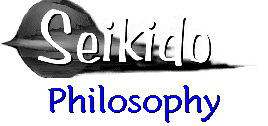
SEIKIDO - SELF DEFENSE PHILOSOPHY
The Seikido self defense techniques are based mainly upon the Japanese art of Aikido, which was founded by Morihei Ueshiba ("O-Sensei"). Ueshiba was a master of older Judo, Jujutsu, and Aikijutsu before he developed Aikido. Therefore the most sound principles of these foundation arts are contained in Aikido. Many techniques are designed to immobilize and disarm attackers who are armed with weapons such as a knife, sword, club, or staff, as well as releases and take downs from holds and grappling attacks.
Aikido (the way of harmony), was derived from Japanese "Bujutsu" (warrior arts), especially Aiki-Jujutsu. Aikido aims to achieve harmony - with the offender, other persons, the environment, the universe, and yourself. The "Budo" (martial way) of Aikido is defined as "the spirit of loving protection for all beings". Qualities most respected include benevolence, politeness, justice, honor, and loyalty.
Everyone has the right to defend themselves; however, the Seikido practitioner must be guided by ethical motives, with the intention to defend himself without hurting others. The student must respect the natural integrity of the opponent's anatomy. With practice, effective self defense becomes possible without the necessity of inflicting serious injury upon an aggressor. True victory is only achieved if no one loses. The Seikido practitioner must be responsible for his own safety, those he is protecting, and for not inflicting unnecessary damage upon the aggressor.
THE ETHICS OF DEFENSE
There are basically four levels of ethical behavior in combat:
- Unprovoked attack with initiative and without provocation, resulting in the injury of death of another person. This is the lowest level and is ethically inexcusable and reprehensible.
- Provoking an attack by insult or a contemptuous attitude, then injuring the other person when they retaliate. The instigator is responsible for inciting the attack, and there is little ethical difference between this level and the one before.
- Defending against an unprovoked attack, where the attacker is injured or killed. Because the defender is not responsible for the attack, this is more defensible ethically than levels one or two; however, the result is the same injury or death of the other person.
- Controlled defending against an unprovoked attack, where neither attacker nor defender is injured. This is the ultimate ethical level of self defense. It requires not only great skill, but also ethical motives and a sincere desire to defend oneself without hurting others. This is the goal of all true self-defense arts and must become the goal of all Seikido practitioners if they are to rise above their performance of physical techniques.
CLASSROOM ETIQUETTE
The practitioner must constantly be guided by a deep respect for the dojo, for all the people in it, and for the purpose of the practice. Good manners, politeness, courteous behavior, and maintenance of formal etiquette are part of a student's training, and essential to developing a respectful attitude to the art. The student should memorize the student rules, and always obey them.
Instructors should monitor the students' commitment to self improvement, and insist on constant self control. The goal is self confidence, to be able to achieve peaceful resolution of conflict wherever possible.
STUDENTS : CODE OF CONDUCT
- Never tire of learning, anywhere, any time; this is the secret of knowledge. Be eager to ask questions and learn. Appreciate the thrill of learning.
- Be willing to sacrifice for the art and the instructor. Respect the skills you are learning, and the efforts it took to bring them to you.
- Never be disrespectful to the instructor. Follow his instructions to the best of your ability.
- Always be loyal to the instructor and the teaching methods. If you disagree with any procedure or technique, discuss it privately with the instructor.
- Practice what you learn and try to perfect your techniques to the best of your abilities. This includes spare time in the gym, and regularly doing conditioning exercises at home on off days.
- Discard any technique you have learned from another school if your instructor disapproves of it.
- Always set a good example for lower belts. Be aware that they will try to emulate senior students.
- Help other students to learn and succeed. Recognize that you are all members of a strong group sharing common goals and interests.
- Remember your conduct inside and outside the gym reflects upon the art and the instructor. Keep in mind that you can not discard your responsibility for the martial arts skills which you have learned, wherever you go.
- Behave honorably. Never be impolite. Try to live by the tenets which guide the art: courtesy, integrity, self control, and perseverance.
WEAPONS OR EQUIPMENT:
All teaching aids must be treated with respect, whether they are real weapons such as a sword or club, simulated weapons such as wooden dowels or plastic knives, targets, shields, sparring equipment, or mats. When giving any weapon to another student, hold it palm up with both hands or the other hand supporting the wrist from below, and bow slightly. Always keep weapons by your right side when on the mat, and never step over any weapon which is lying on the floor.
Created by XSystyms © Copyright 1996